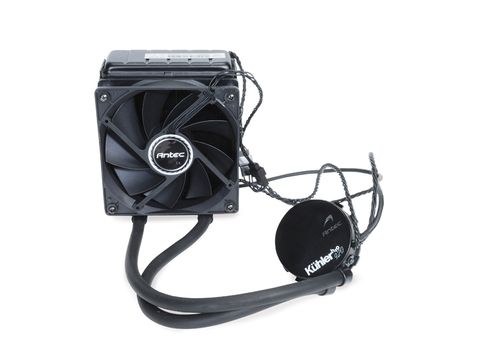TechRadar Verdict
Pros
- +
Great load temperatures
- +
Highly tweakable software
Cons
- -
Underwhelming idle temps
- -
Ungraceful fitting mechanism
Why you can trust TechRadar
Whether you're into your overclocking or simply determined to keep internal case temperatures to a minimum, we reckon a self-contained liquid cooling kit like the Antec Kuhler H2O 920 offering is your best bet at the moment if you're prepared to pay a bit extra. Or maybe a lot extra.
The 920 is pricier than some like Antec's own £40 Kuhler 620, and the difference between this kit and entry-level liquid cooling is subtle. But that's often the way with enthusiast gear – some people will always be willing to pay top dollar for that extra one per cent.
That's not to say the difference is that slim between the 620 and 920. There are two 120mm fans to strap to the radiator, one keeping the aluminium corrugation cool before the hot liquid arrives, one on the other side to chuck it out of your case.
These fans hook up to the pump, which hooks up to a spare USB controller on your motherboard. That lets you control the fan speeds via a software layer once you get to Windows.
Ready, set… blow!
It all sounds a bit like last month's Corsair H100, doesn't it? Well, there are some key differences.
Corsair's radiator is twice as long, which makes it compatible with only certain cases, and rather than using a software layer, fan speed's adjusted by either pressing a button on the pump itself, or hooking it up to Corsair Link, which monitors temps all around your case.
The two liquid cooling kits are roughly the same price, though we did manage to find the Corsair H100 for £76 at the time of writing.
It's not quite a straight performance stand-off between the two, though. As the Corsair stands limber and ready to draw its pistols, the Kühler H2O 920 struggles to get its six shooters out of its holsters. And by that opaque metaphor, we obviously mean that Antec's bracket design lets this kit down.
Quite simply, it's a pain in the perineum to fit, especially in light of the H100's effortless bracket design. After the swearing dies down and the H2O 920 is fitted, the results are pretty agreeable. We're especially impressed by its low load temperature with the fans running at 100 per cent, and the swift load to idle recovery time of around 12 seconds.
However, the Corsair H100 is much more effective in reducing idle temps, as the benchmarks illustrate.
TechRadar Labs

Idle temperature performance
X6 1100T: Degrees Centigrade: Lower is better
Antec Kuhler H2O 920: 28
Corsair H100: 20
Arctic Cooling Freezer 13: 33
Load temperature performance
X6 1100T: Degrees Centigrade: Lower is better
Antec Kuhler H2O 920: 34
CORSAIR H100: 34
Arctic Cooling Freezer 13: 51
Fine tuning
The bundled software allows you to create and customise your own profiles, telling the cooler at which temperature you want it to hit a certain fan speed, allowing for some really fine tuning.
The default profile has some problems, though. We found the load to idle temperature recovery time took… well it just never really recovered. We stopped counting after four minutes.
The H2O 920 isn't nearly as effective at slower fan speeds, and bearing in mind there's a fairly deafening 54dB buzz when full blown, it's food for thought.
Once you've spent the time creating your perfect profile, the H2O 920 is a very effective cooler, and if your chassis won't fit the Corsair H100's giant radiator, this setup from Antec will see you right.
Follow TechRadar Reviews on Twitter: http://twitter.com/techradarreview

Ad creative by day, wandering mystic of 90s gaming folklore by moonlight, freelance contributor Phil started writing about games during the late Byzantine Empire era. Since then he’s picked up bylines for The Guardian, Rolling Stone, IGN, USA Today, Eurogamer, PC Gamer, VG247, Edge, Gazetta Dello Sport, Computerbild, Rock Paper Shotgun, Official PlayStation Magazine, Official Xbox Magaine, CVG, Games Master, TrustedReviews, Green Man Gaming, and a few others but he doesn’t want to bore you with too many. Won a GMA once.

